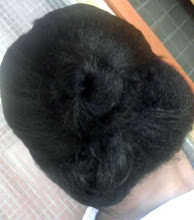When your hair is relaxed, it's more fragile as a result of the breaking of the protein bonds hence using a protein based product fills the vacuum created. The protein won't restore the lost one; it will serve as a sort of adhesive to hold the bonds together.
The strength of the protein depends on the level of damage. Light protein can be used as a preventive step before relaxing; mitigating the impact of protein loss during relaxer application.
Hard Protein comes in when you have mushy hair as a result of moisture overload to strengthen the hair or if your hair is extremely damaged from chemicals and dyes.
How your hair responds to any of these will be the ultimate deciding factor. Hard Protein treatment should be followed by a moisture deep conditioner as it leaves the hair hard. Light protein doesn't usually have the same level of hardness.
Protein for Natural Hair
Yes, your natural hair doesn't need that much protein reinforcement unless you've been using heat, dye etc which affects the hair.
Personally, if you live in this part of the world (Africa), moisture deep conditioners should be your priority. Your hair needs just a bit of protein whereas our weather can suck every moisture out of your hair hence the need for moisture based products
What's your favourite protein product?
The strength of the protein depends on the level of damage. Light protein can be used as a preventive step before relaxing; mitigating the impact of protein loss during relaxer application.
Hard Protein comes in when you have mushy hair as a result of moisture overload to strengthen the hair or if your hair is extremely damaged from chemicals and dyes.
How your hair responds to any of these will be the ultimate deciding factor. Hard Protein treatment should be followed by a moisture deep conditioner as it leaves the hair hard. Light protein doesn't usually have the same level of hardness.
Protein for Natural Hair
Yes, your natural hair doesn't need that much protein reinforcement unless you've been using heat, dye etc which affects the hair.
Personally, if you live in this part of the world (Africa), moisture deep conditioners should be your priority. Your hair needs just a bit of protein whereas our weather can suck every moisture out of your hair hence the need for moisture based products
What's your favourite protein product?


Comments
Post a Comment
Speak your mind; I love to hear from you!